(Jim Cooke / Los Angeles Times)
25 shady L.A.-area spots to beat the heat right now
- Share via
Trees can solve so many problems.
On the hottest of summer days, their evergreen canopies cool our homes and streets and shelter us from ultraviolet rays.
Anyone who has gotten lost in the intricate details of an ancient African Cape chestnut tree in Elysian Park or the thick bark of a coast live oak in La Cañada Flintridge knows they are magical too.
Here are several of our favorite places to find shade in the L.A. area, including parks and public gardens.
Dog parks, coffee shops, desert raves, breakfast meetups, community centers and hiking groups are keys to making friends in Los Angeles.
Showing Places
Arlington Garden
Pasadena Garden
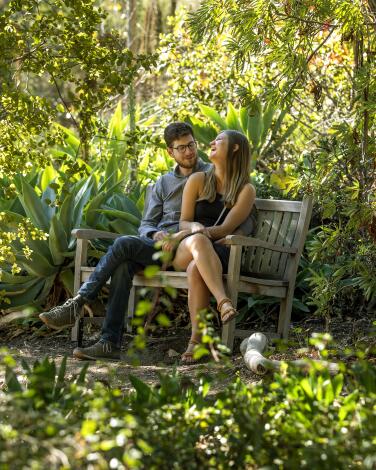
(Mel Melcon / Los Angeles Times)
Once upon a time, Arlington Garden was the site of a grand 50-room mansion known as Durand House, which was demolished after 1964 so the California Department of Transportation could extend the 710 Freeway. When community opposition halted that project, the 3-acre lot of compacted dirt stood vacant until 2005. That’s when the garden’s founders, Betty and Charles McKenney, worked with Pasadena officials to create a public, water-wise Mediterranean-style garden. Its designers used organic and regenerative growing techniques such as leaving leaf litter on the ground to help build up the depleted soil. They also packed in nearly as many garden “spaces” as there were rooms in the old mansion, with lots of quiet shady spots for reading, trails and a labyrinth to stroll, a citrus grove, an oak grove, a vegetable patch, a pond, a cactus garden, a pine forest and a French-feeling allée lined with silvery olive trees and furniture you can move about for personalized seating. And, of course, the garden is laced with lots of habitat-creating native plants, as is obvious from the birdsong and pollinators flitting throughout.
This is a garden where you can bring a book or a picnic, let children safely run free or find a sheltered corner for coffee and intense conversation. During a visit late on a fall Friday afternoon, one young woman sat in a corner of the allée with her sketch pad; a slender walker gaped at the white barrel-shaped blooms oozing with bees on a tall San Pedro cactus (Echinopsis pachanoi); and a toddler wheeled and shrieked with excitement at finding a pumpkin in the vegetable patch. Use this garden as you would a pair of comfortable shoes — as often as you can, with gratitude and love.
Admission: Free
Hours: Open daily from sunrise to sunset.
Food: You can’t purchase food at the garden, but there are areas for eating prepared foods; just make sure to clean up afterward. The garden’s famous marmalade, made from oranges picked from its trees, is available for purchase at several locations in Pasadena but not normally in the garden.
Other: There is no publicly accessible restroom, but there is a water bottle refill station in the back of the garden, on the garden shed. Dogs are permitted if leashed.
This is a garden where you can bring a book or a picnic, let children safely run free or find a sheltered corner for coffee and intense conversation. During a visit late on a fall Friday afternoon, one young woman sat in a corner of the allée with her sketch pad; a slender walker gaped at the white barrel-shaped blooms oozing with bees on a tall San Pedro cactus (Echinopsis pachanoi); and a toddler wheeled and shrieked with excitement at finding a pumpkin in the vegetable patch. Use this garden as you would a pair of comfortable shoes — as often as you can, with gratitude and love.
Admission: Free
Hours: Open daily from sunrise to sunset.
Food: You can’t purchase food at the garden, but there are areas for eating prepared foods; just make sure to clean up afterward. The garden’s famous marmalade, made from oranges picked from its trees, is available for purchase at several locations in Pasadena but not normally in the garden.
Other: There is no publicly accessible restroom, but there is a water bottle refill station in the back of the garden, on the garden shed. Dogs are permitted if leashed.
Show more Show less
Route Details
Audubon Center at Debs Park
Montecito Heights Park
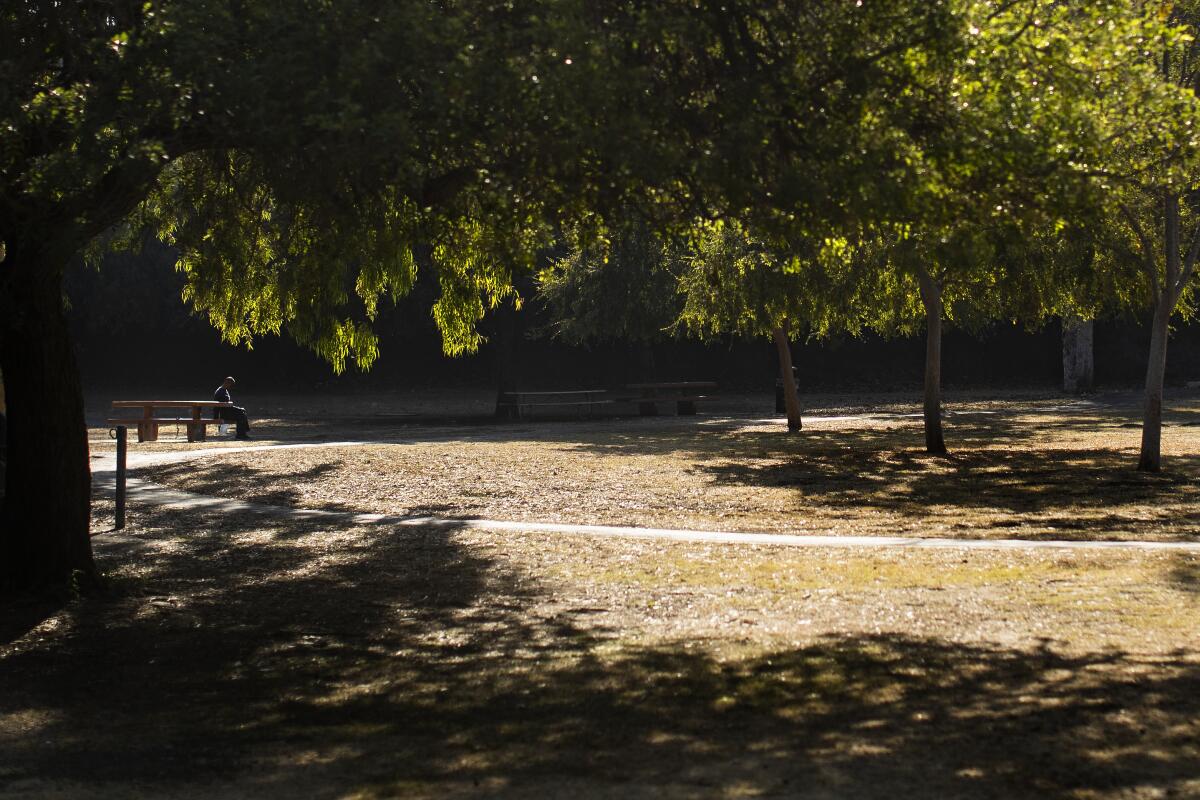
(Gina Ferazzi / Los Angeles Times)
The urban nature center in Montecito Heights has a beautiful tree canopy consisting of mostly Southern California black walnut, toyon and coast live oak. It’s a terrific place to walk and bird watch, as the park is home to more than 140 species of birds, including American kestrels, great horned owls, northern flickers and yellow-rumped warblers. Picnic in the shade of the park’s large eucalyptus trees or explore one of the many trails, including a hike to a hilltop lake with views of nearby downtown Los Angeles.
Admission: Free
Hours: Open daily from 8 a.m. to 4 p.m. Closed Tuesdays.
Admission: Free
Hours: Open daily from 8 a.m. to 4 p.m. Closed Tuesdays.
Show more Show less
Route Details
California Botanic Garden
Claremont Garden
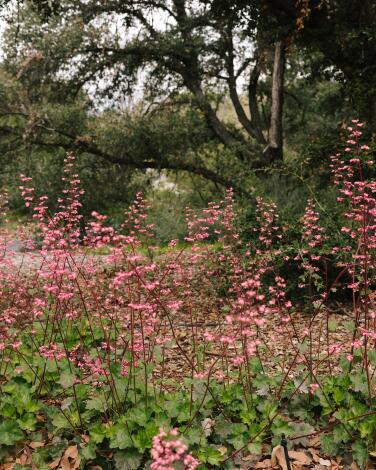
(Dania Maxwell/Los Angeles Times)
California Botanic Garden considers itself an 86-acre living museum, the state’s largest collection of native plants. The easy-to-roam area is divided into multiple regions such as a fan palm oasis and clumps of serrated agaves, a wildflower meadow, redwood groves, waves of Matilija poppies (whose fried-egg-looking blooms are the size of one’s hand) and a dizzying collection of manzanita and wildflower blooms in the spring. Be sure to visit the massive 250-year-old majestic oak, the largest and oldest in the garden’s oak woodlands. There are many sturdy benches that invite reflection and maybe a snack, but food is permitted only in the parking area.
This is a lovely garden to learn how native plants look when they’re mature. The garden’s website lists what’s currently in bloom, and from October to May, you can purchase many of the plants you admire in the on-site Grow Native Nursery. Note: This is a great place to appreciate the heady fragrance of many California native plants. A slight stroke of a branch can fill the air with scent. Just be gentle when you walk by.
Admission: $10, $6 seniors and students, $4 ages 3-12, and free entry for members and children under 3. Annual memberships start at $50 for individuals and $85 for families.
Hours: Open 8 a.m. to 8 p.m. Tuesday to Sunday.
Food is not permitted in the gardens. No pets permitted except trained service dogs.
This is a lovely garden to learn how native plants look when they’re mature. The garden’s website lists what’s currently in bloom, and from October to May, you can purchase many of the plants you admire in the on-site Grow Native Nursery. Note: This is a great place to appreciate the heady fragrance of many California native plants. A slight stroke of a branch can fill the air with scent. Just be gentle when you walk by.
Admission: $10, $6 seniors and students, $4 ages 3-12, and free entry for members and children under 3. Annual memberships start at $50 for individuals and $85 for families.
Hours: Open 8 a.m. to 8 p.m. Tuesday to Sunday.
Food is not permitted in the gardens. No pets permitted except trained service dogs.
Show more Show less
Route Details
Chavez Ravine Arboretum
Elysian Park Park

(Dania Maxwell / Los Angeles Times)
Grand in scale, with approximately 140 types of trees from all over the world, the oldest arboretum in Los Angeles offers plenty of room to escape the heat. You’ll find picnic tables, barbecue grills, drinking fountains and public restrooms, and on some Sundays, a lowrider car show on nearby Stadium Way in Elysian Park.
Wander the park and take in the many rare specimens: floss silk trees (Chorisia speciosa) from South America, noted for their pink flowers and sharp conical prickles on their trunks; the Dombeya wallichii trees, native to Madagascar, located near the Grace E. Simons Lodge and known for smelling like cake frosting when in bloom; the tallest Queensland kauri (Agathis robusta) in the continental U.S. at 120 feet high; the first Cape chestnut (Calodendron capense) and a bald cypress (Taxodium distichum var. nutans).
During the pandemic, the arboretum became popular with yoga instructors who held class in the shade of the park’s magnificent trees. In a positive twist to the pandemic, it’s a trend that continues.
Admission: Free
Hours: Sunrise to sunset
Wander the park and take in the many rare specimens: floss silk trees (Chorisia speciosa) from South America, noted for their pink flowers and sharp conical prickles on their trunks; the Dombeya wallichii trees, native to Madagascar, located near the Grace E. Simons Lodge and known for smelling like cake frosting when in bloom; the tallest Queensland kauri (Agathis robusta) in the continental U.S. at 120 feet high; the first Cape chestnut (Calodendron capense) and a bald cypress (Taxodium distichum var. nutans).
During the pandemic, the arboretum became popular with yoga instructors who held class in the shade of the park’s magnificent trees. In a positive twist to the pandemic, it’s a trend that continues.
Admission: Free
Hours: Sunrise to sunset
Show more Show less
Route Details
Conejo Valley Botanic Garden
Thousand Oaks Garden

(Jeanette Marantos / Los Angeles Times)
East Ventura County gets hot in the summer, but if you’re lucky enough to live near Conejo Valley Botanic Garden in Thousand Oaks, you’ve got a cool, shady — and free! — place to visit every day, filled with ever-changing flowers, shrubs and trees to keep the walk interesting. The garden is on a hill, so the paths are like wide, gentle switchbacks with lovely views at the top. There are some modestly steep climbs in places. Be sure to wear sturdy walking shoes and bring your own water. There are restrooms in the parking area, next to the adjacent Conejo Community Park.
This is a good place to bring children, with a stream running through, bridges here and there, and plenty of plant diversity, from a rare-fruit orchard and oak grove to gardens dedicated to butterflies, a bird habitat, desert cactuses and succulents, herbs, Australian plants, colorful native salvia and a “Trail of Trees” (more than 50 varieties of trees planted in 2005 to restore a slope covered with invasive mustard weed). The Rare Fruit Orchard at the top of the hill includes 99 trees planted by the California Rare Fruit Growers, featuring 34 varieties from 19 countries as a demonstration of Southern California’s versatile growing environment.
There’s also a special garden for children open from 11 a.m. to 3 p.m. on Sundays only. Another impressive fact: This nonprofit botanic garden was started by three local volunteers in 1973 — Ray Garcia, Fred Wilson and Jackson Granholm — after a housing developer donated the hilly, unbuildable 33 acres to the Conejo Recreation and Park District, according to botanic garden president Beverly Brune. Today, the gardens comprise 41 acres and are completely managed by volunteers and funded by money raised by grants and fundraisers such as the garden nursery, which sells plants propagated from the garden from 9 to 11 a.m. Wednesdays and from 11 a.m. to 3 p.m. Sundays in the Kids’ Adventure Garden.
Admission: Free
Hours: Open daily, sunrise to sunset, except July 4 and when trail conditions are wet. The Kids’ Adventure Garden is open only on Sundays, from 11 a.m. to 3 p.m. The garden nursery sells plants on Wednesdays from 9:30 a.m. to noon.
Food: Food is not permitted in the gardens.
Other: Dogs are permitted if leashed. Restrooms are located in the parking lot, next to Conejo Community Park.
This is a good place to bring children, with a stream running through, bridges here and there, and plenty of plant diversity, from a rare-fruit orchard and oak grove to gardens dedicated to butterflies, a bird habitat, desert cactuses and succulents, herbs, Australian plants, colorful native salvia and a “Trail of Trees” (more than 50 varieties of trees planted in 2005 to restore a slope covered with invasive mustard weed). The Rare Fruit Orchard at the top of the hill includes 99 trees planted by the California Rare Fruit Growers, featuring 34 varieties from 19 countries as a demonstration of Southern California’s versatile growing environment.
There’s also a special garden for children open from 11 a.m. to 3 p.m. on Sundays only. Another impressive fact: This nonprofit botanic garden was started by three local volunteers in 1973 — Ray Garcia, Fred Wilson and Jackson Granholm — after a housing developer donated the hilly, unbuildable 33 acres to the Conejo Recreation and Park District, according to botanic garden president Beverly Brune. Today, the gardens comprise 41 acres and are completely managed by volunteers and funded by money raised by grants and fundraisers such as the garden nursery, which sells plants propagated from the garden from 9 to 11 a.m. Wednesdays and from 11 a.m. to 3 p.m. Sundays in the Kids’ Adventure Garden.
Admission: Free
Hours: Open daily, sunrise to sunset, except July 4 and when trail conditions are wet. The Kids’ Adventure Garden is open only on Sundays, from 11 a.m. to 3 p.m. The garden nursery sells plants on Wednesdays from 9:30 a.m. to noon.
Food: Food is not permitted in the gardens.
Other: Dogs are permitted if leashed. Restrooms are located in the parking lot, next to Conejo Community Park.
Show more Show less
Route Details
Corriganville Park
Park

(Michael Owen Baker / For The Times)
The former Simi Valley movie ranch features four trails shaded by coast live oak, willows and sycamore trees.
Movies that were filmed here include “Fort Apache,” starring John Wayne; “Jungle Jim,” starring Johnny Weissmuller; and “The Three Musketeers,” starring Lana Turner and Gene Kelly. TV shows include “Bonanza” and “The Lone Ranger.”
Today, the interpretive trail includes 20 informative signs that indicate indigenous plants and animals as well as the historical spots where movies and TV shows were filmed, including “Sherwood Forest,” where “Robin Hood” was shot.
Admission: Free
Hours: Open daily from sunrise to sunset.
Movies that were filmed here include “Fort Apache,” starring John Wayne; “Jungle Jim,” starring Johnny Weissmuller; and “The Three Musketeers,” starring Lana Turner and Gene Kelly. TV shows include “Bonanza” and “The Lone Ranger.”
Today, the interpretive trail includes 20 informative signs that indicate indigenous plants and animals as well as the historical spots where movies and TV shows were filmed, including “Sherwood Forest,” where “Robin Hood” was shot.
Admission: Free
Hours: Open daily from sunrise to sunset.
Show more Show less
Route Details
Crescenta Valley Community Regional Park
Park
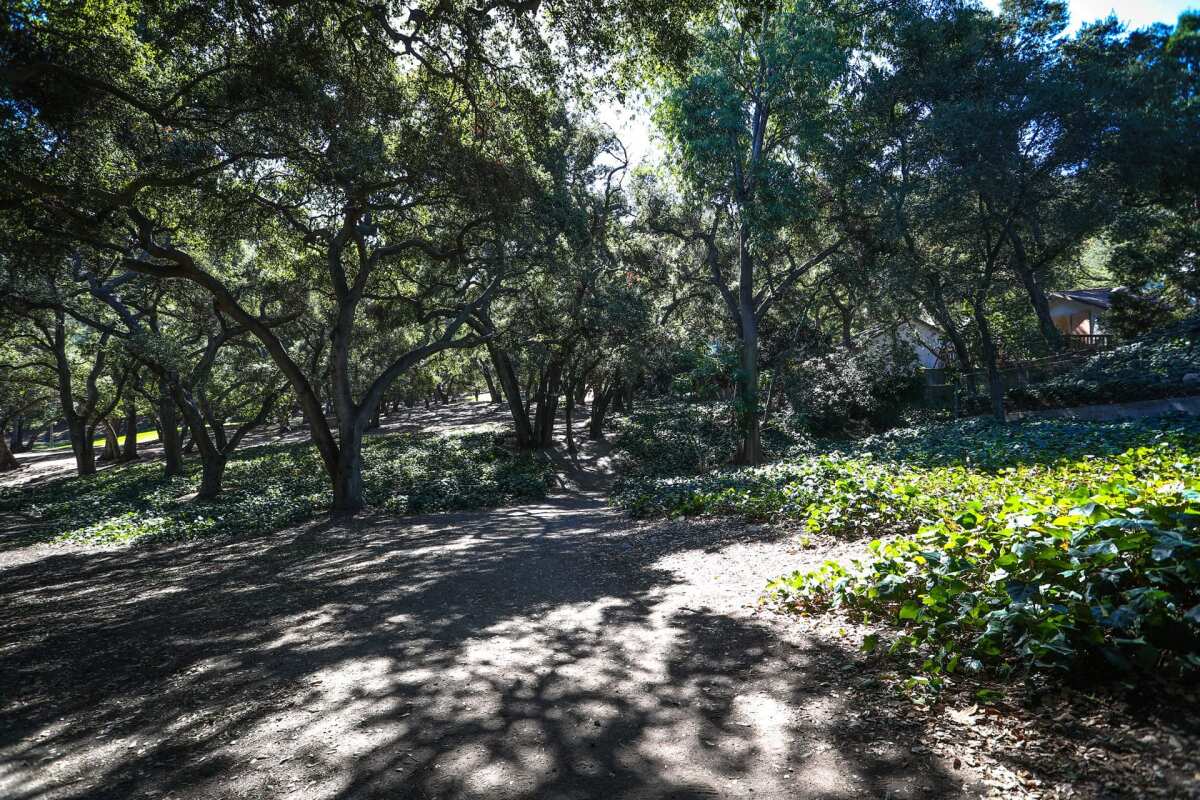
(L.A. County Department of Parks and Recreation)
Half of the park, which features three miles of trails shaded by sycamores and coast live oaks, loops around to the base of the Verdugos, where you might find coyote and bobcat scat from the night before.
There is a shaded playground behind the baseball fields off New York Avenue as well as a more-than-10,000-square-foot skate park with shade structures, a dog park and basketball courts. There are plenty of picnic tables as well as group picnic shelters, but the best place to relax is under the shade of one of the park’s many trees.
Hours: 6:30 a.m. to 9 p.m. daily
There is a shaded playground behind the baseball fields off New York Avenue as well as a more-than-10,000-square-foot skate park with shade structures, a dog park and basketball courts. There are plenty of picnic tables as well as group picnic shelters, but the best place to relax is under the shade of one of the park’s many trees.
Hours: 6:30 a.m. to 9 p.m. daily
Show more Show less
Route Details
Descanso Gardens
La Cañada Flintridge Garden

(Christina House / Los Angeles Times)
Think of Descanso Gardens as part chameleon, part sanctuary. Walking through its towering oak woodlands and ancient forest is kind of a religious experience — silent, awe-inspiring and very intimate. But then there are the flower gardens, starting with 5 acres of roses — more than 1,600 varieties — and a Japanese Garden with a teahouse and delicate blooms from cherry and plum trees and other plantings native to Asia. There’s also the California Garden, designed by native plant advocate Theodore Payne; masses of blooming tulips in the spring; and one of the country’s largest collections of camellias, which bloom best in January and February, when most flowers are resting.
Visit often to check out the changing gardens because there’s always something blooming at Descanso. Whether you’re feeling reflective or joyous, this garden will always be uplifting.
Admission: $15, $11 for seniors 65 and over and students with ID, $5 for children ages 5-12, members and children under 5 enter free. Annual memberships start at $70 for individuals and $99 for families.
Hours: 9 a.m. to 7 p.m. Monday-Friday, 9 a.m. to 5 p.m. Saturday-Sunday during the summer.
Food can be purchased on-site daily at the Kitchen at Descanso from 9 a.m. to 4:30 p.m. During the summer, food can be purchased from 9 a.m. to 6:30 p.m. Monday-Friday and 9 a.m. to 4:30 p.m. Saturday-Sunday.
Visit often to check out the changing gardens because there’s always something blooming at Descanso. Whether you’re feeling reflective or joyous, this garden will always be uplifting.
Admission: $15, $11 for seniors 65 and over and students with ID, $5 for children ages 5-12, members and children under 5 enter free. Annual memberships start at $70 for individuals and $99 for families.
Hours: 9 a.m. to 7 p.m. Monday-Friday, 9 a.m. to 5 p.m. Saturday-Sunday during the summer.
Food can be purchased on-site daily at the Kitchen at Descanso from 9 a.m. to 4:30 p.m. During the summer, food can be purchased from 9 a.m. to 6:30 p.m. Monday-Friday and 9 a.m. to 4:30 p.m. Saturday-Sunday.
Show more Show less
Route Details
El Dorado Nature Center
Long Beach Park
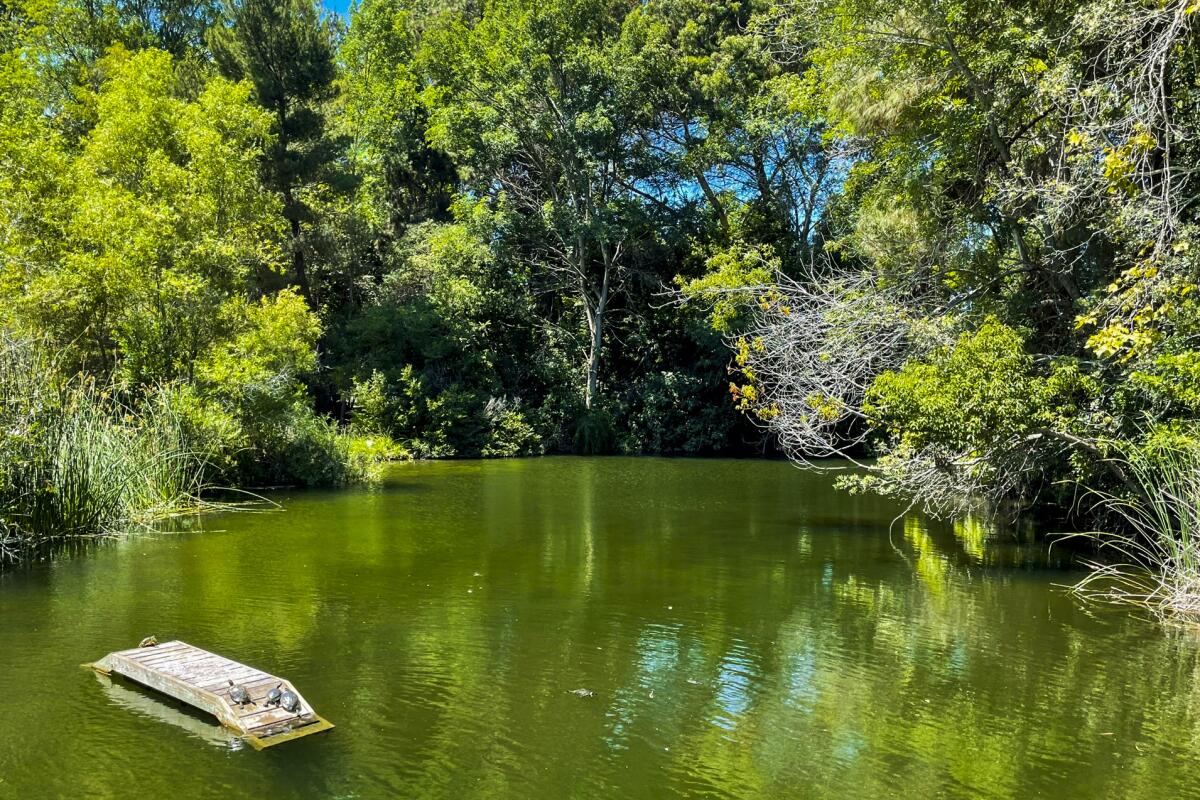
(Mary Forgione / Los Angeles Times)
Established in 1969, this man-made 105-acre park is a densely wooded park within a park that includes two stocked fishing lakes, a stream, tree-lined meadows, two miles of dirt walking trails and a 1/4-mile paved trail.
The nature center features many California native plant varieties, including oaks, redwoods and a white alder grove. It also has an art gallery and gift shop on a small island in one of the lakes. The park is popular with bird watchers who flock to the park to see the more than 150 resident and migratory bird species that have been spotted here.
After a hike, explore surrounding El Dorado East Regional Park, which has a dog park, more lakes and shaded places to seek out on a hot day.
Hours for trails: Open 8 a.m. to 5 p.m. Tuesdays through Sundays. No trail entry after 4:30 p.m.
Admission: Parking is limited and costs $6 and up, cash only. Pedestrians and cyclists enter free.
The nature center features many California native plant varieties, including oaks, redwoods and a white alder grove. It also has an art gallery and gift shop on a small island in one of the lakes. The park is popular with bird watchers who flock to the park to see the more than 150 resident and migratory bird species that have been spotted here.
After a hike, explore surrounding El Dorado East Regional Park, which has a dog park, more lakes and shaded places to seek out on a hot day.
Hours for trails: Open 8 a.m. to 5 p.m. Tuesdays through Sundays. No trail entry after 4:30 p.m.
Admission: Parking is limited and costs $6 and up, cash only. Pedestrians and cyclists enter free.
Show more Show less
Route Details
Fern Dell
Park
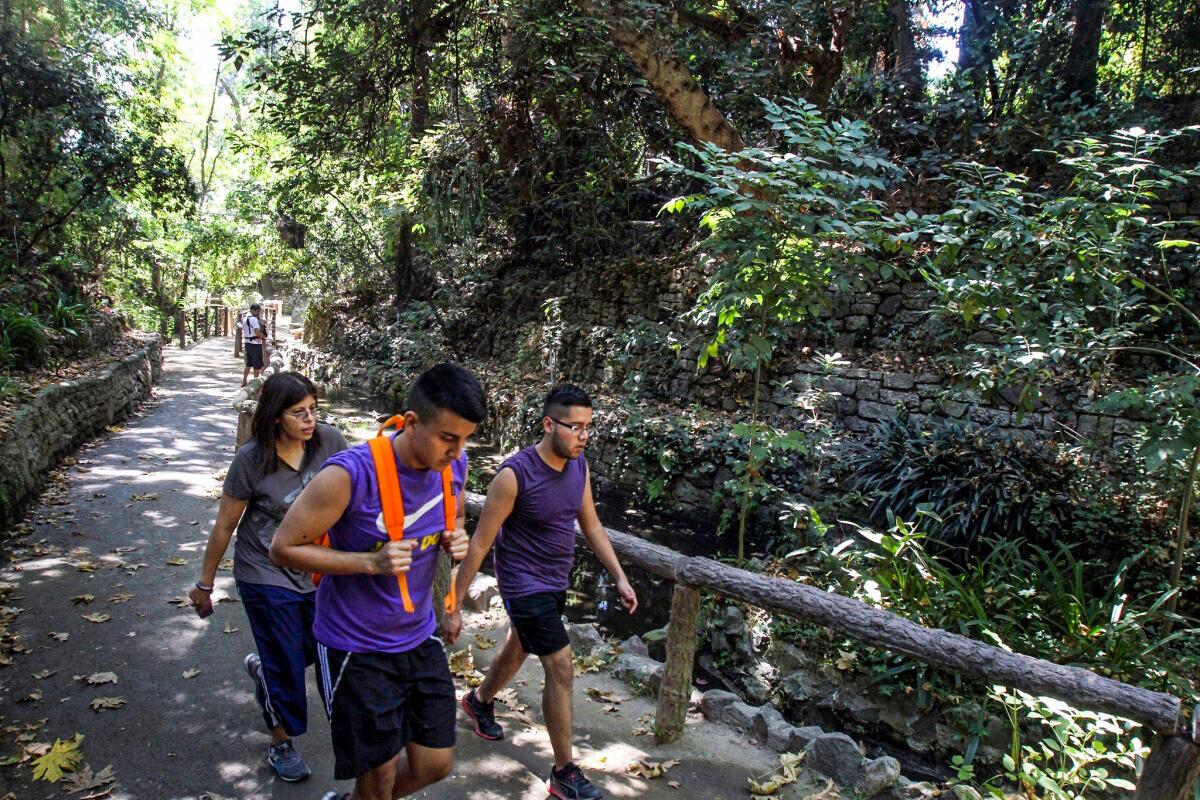
(Cheryl A. Guerrero / Los Angeles Times)
Even in summer, this 20-acre tree-shaded trail in Griffith Park is cool, as the path follows a trickling stream dotted with native coast live oak, Western sycamore, climbing English ivy, a huge Roxburgh fig tree and California coastal redwoods.
More than 50 fern species, including some that are California natives, thrive along the shady trail located near the Western Canyon entrance off Los Feliz Boulevard. Non-native varieties include ferns from Africa, South America, Australia and Southeast Asia.
If you’re up for a hike, the paved walkway becomes a dirt path that will take you to Griffith Park Observatory and the Mt. Hollywood peak, which is about a 5-mile loop. Afterward, enjoy coffee and a snack in the shade at Trails Cafe, which is open from 8 a.m. to 2 p.m.; closed Tuesdays and Wednesdays.
Hours: 5 a.m. to 10:30 p.m. daily
More than 50 fern species, including some that are California natives, thrive along the shady trail located near the Western Canyon entrance off Los Feliz Boulevard. Non-native varieties include ferns from Africa, South America, Australia and Southeast Asia.
If you’re up for a hike, the paved walkway becomes a dirt path that will take you to Griffith Park Observatory and the Mt. Hollywood peak, which is about a 5-mile loop. Afterward, enjoy coffee and a snack in the shade at Trails Cafe, which is open from 8 a.m. to 2 p.m.; closed Tuesdays and Wednesdays.
Hours: 5 a.m. to 10:30 p.m. daily
Show more Show less
Route Details
Arboretum and Botanical Garden at Cal State Fullerton
Fullerton Garden

(Los Angeles Times)
What a surprise to find such a lush 26-acre garden on the campus of Cal State Fullerton, bounded by the Titan Stadium and the always busy Yorba Linda Boulevard and 57 Freeway. With all the traffic noise and the sound of cracking bats during practice at the stadium, it’s hard to believe there can be anything tranquil inside the garden gates. However, once inside, past the waterfall and banana trees heavy with fruit, it’s easy to forget all that other stuff and just get swept away by this garden’s “living collection,” created in the 1970s on an old Valencia orange grove with diseased trees that couldn’t be saved.
Wide lawns near the entrance lead to two ponds full of sunning turtles, connected by a shallow, fast-moving stream that burbles through the west side of the gardens. It might be hot outside, but the temperature drops significantly inside the bamboo forest, redwood grove and a collection of huge and wonderfully twisted fig trees.
Don’t miss the spectacular rock fig with its pale green trunks rising ghost-like from the heavily leaf-littered ground. At the east side of the garden is the Thorn Forest, with truly bizarre plants such as the silk floss tree, with its spike-studded branches and trunk and delicate lily-like blooms. Then suddenly, after all the forests, you are smack in the desert, studded with barrel cactuses, towering agave blooms and a bit of shade from massive Chilean mesquite trees. The rare-fruit orchard and citrus groves remind us we live in Southern California, and if you’re lucky, you can purchase some of the bounty at the gate, such as bags of fresh fuyu persimmons, sapotes, star fruit and pomegranates.
Admission: $5 suggested donation. Members enter free.
Hours: 9 a.m. to 4 p.m. daily; closed on most university-recognized holidays.
Food: No food is available for purchase at the arboretum, except for fruit that’s sometimes sold at the gate. Food and picnics are not permitted inside the garden, but there are benches and tables outside the front entrance where people can eat.
Other: Restrooms are located near the entrance. No pets are permitted except trained service dogs.
Wide lawns near the entrance lead to two ponds full of sunning turtles, connected by a shallow, fast-moving stream that burbles through the west side of the gardens. It might be hot outside, but the temperature drops significantly inside the bamboo forest, redwood grove and a collection of huge and wonderfully twisted fig trees.
Don’t miss the spectacular rock fig with its pale green trunks rising ghost-like from the heavily leaf-littered ground. At the east side of the garden is the Thorn Forest, with truly bizarre plants such as the silk floss tree, with its spike-studded branches and trunk and delicate lily-like blooms. Then suddenly, after all the forests, you are smack in the desert, studded with barrel cactuses, towering agave blooms and a bit of shade from massive Chilean mesquite trees. The rare-fruit orchard and citrus groves remind us we live in Southern California, and if you’re lucky, you can purchase some of the bounty at the gate, such as bags of fresh fuyu persimmons, sapotes, star fruit and pomegranates.
Admission: $5 suggested donation. Members enter free.
Hours: 9 a.m. to 4 p.m. daily; closed on most university-recognized holidays.
Food: No food is available for purchase at the arboretum, except for fruit that’s sometimes sold at the gate. Food and picnics are not permitted inside the garden, but there are benches and tables outside the front entrance where people can eat.
Other: Restrooms are located near the entrance. No pets are permitted except trained service dogs.
Show more Show less
Route Details
The Huntington Library, Art Museum, and Botanical Gardens
San Marino Botanic Garden

(Kent Nishimura / Los Angeles Times)
The Huntington Library, Art Museum, and Botanical Gardens is the grand dame of Southern California botanic gardens. (It’s as large and formidable as its name.)
If you go, plan a day devoted to just wandering the Huntington’s 130-acre gardens, a sprawling collection of extraordinary roses, authentic Chinese and Japanese gardens, and areas dedicated to Australian plants, Shakespearean plants, herbs, desert plants, jungle and subtropical plants (you can almost hear Tarzan bellowing somewhere in those towering, vine-dripping trees) and, of course, a whimsical garden to enchant children. The food options are varied and very good.
If you want a free-day ticket (the first Thursday of every month), you’ll need to be strategic, ready to jump on a reservation at 9 a.m. the Thursday before. Due to the huge demand, people are assigned a random number after they enter the online waiting room for free tickets. If your number is selected, you can receive up to five tickets per household (babies also need tickets on free days).
Hours: Hours are 10 a.m. to 5 p.m. Wednesday-Monday, closed Tuesdays. Reservations required for weekend visits.
Admission: Prices start at $25 weekdays and $29 on weekends; slightly lower fees for seniors, students and children. Members and children under 4 enter free. Free days — the first Thursday of every month — require advance reservations made the week prior, and spots fill up quickly. Members are not permitted on free days. Annual memberships start at $159; you can apply up to $50 of your admission fees toward a membership within 24 hours of your visit.
Food is available at several on-site cafes. No pets permitted except trained service dogs.
If you go, plan a day devoted to just wandering the Huntington’s 130-acre gardens, a sprawling collection of extraordinary roses, authentic Chinese and Japanese gardens, and areas dedicated to Australian plants, Shakespearean plants, herbs, desert plants, jungle and subtropical plants (you can almost hear Tarzan bellowing somewhere in those towering, vine-dripping trees) and, of course, a whimsical garden to enchant children. The food options are varied and very good.
If you want a free-day ticket (the first Thursday of every month), you’ll need to be strategic, ready to jump on a reservation at 9 a.m. the Thursday before. Due to the huge demand, people are assigned a random number after they enter the online waiting room for free tickets. If your number is selected, you can receive up to five tickets per household (babies also need tickets on free days).
Hours: Hours are 10 a.m. to 5 p.m. Wednesday-Monday, closed Tuesdays. Reservations required for weekend visits.
Admission: Prices start at $25 weekdays and $29 on weekends; slightly lower fees for seniors, students and children. Members and children under 4 enter free. Free days — the first Thursday of every month — require advance reservations made the week prior, and spots fill up quickly. Members are not permitted on free days. Annual memberships start at $159; you can apply up to $50 of your admission fees toward a membership within 24 hours of your visit.
Food is available at several on-site cafes. No pets permitted except trained service dogs.
Show more Show less
Route Details
Kenneth Hahn State Recreation Area
Ladera Heights Park
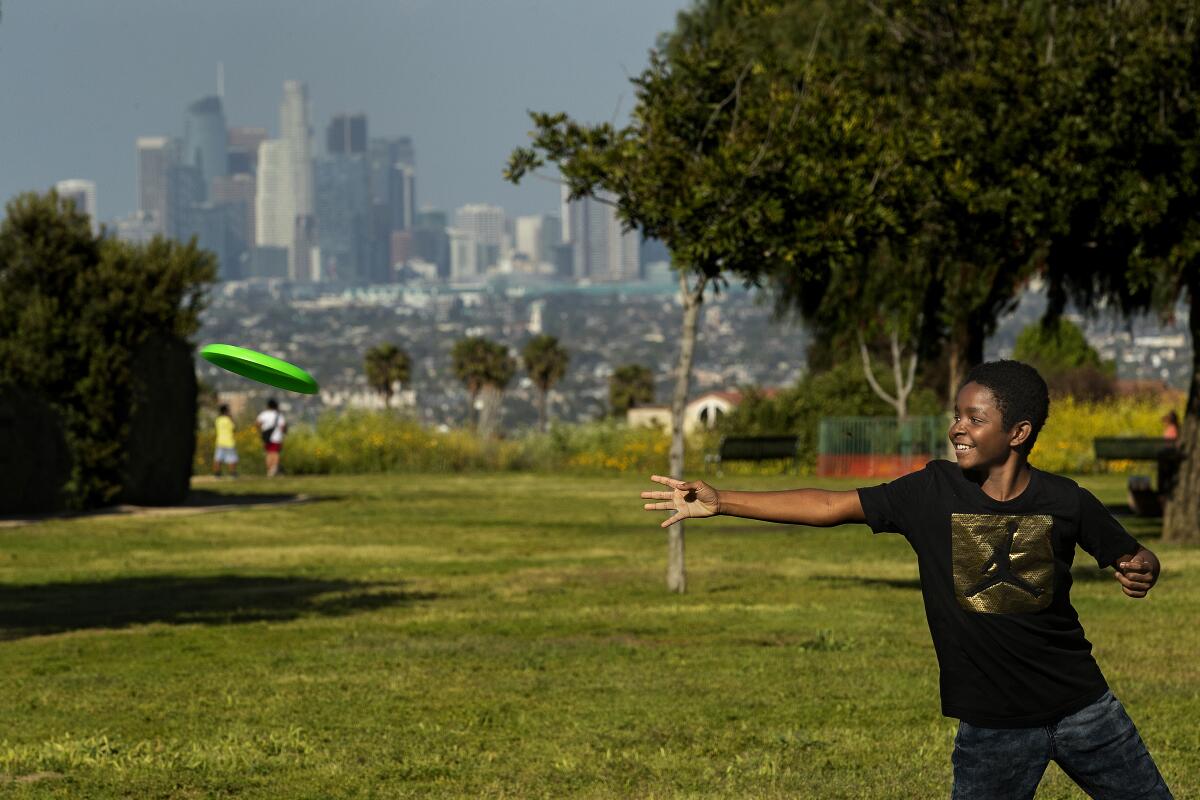
(Mel Melcon / Los Angeles Times)
Enjoy the shadow of eucalyptus, sumac and oak trees inside the 308-acre recreation area, just off La Cienega Boulevard in Baldwin Hills.
In addition to stunning city views of Los Angeles, the park houses a lotus-filled pond, a rushing stream, a grove of low-growing California pepper trees and a Japanese garden.
On Sundays, WalkGood L.A. offers a one-hour, donation-based BreatheGood Vinyasa yoga flow class at 9:45 a.m. in the park. Bring a yoga mat, water and towel.
Hours: 6 a.m. to 8 p.m. daily
Parking: $7 cash
In addition to stunning city views of Los Angeles, the park houses a lotus-filled pond, a rushing stream, a grove of low-growing California pepper trees and a Japanese garden.
On Sundays, WalkGood L.A. offers a one-hour, donation-based BreatheGood Vinyasa yoga flow class at 9:45 a.m. in the park. Bring a yoga mat, water and towel.
Hours: 6 a.m. to 8 p.m. daily
Parking: $7 cash
Show more Show less
Route Details
Los Angeles County Arboretum & Botanic Garden
Arcadia Botanic Garden

(Gabriella Angotti-Jones / Los Angeles Times)
There are plenty of beautiful places to wander here, such as the aquatic gardens that include the Meyberg Waterfall, the Meadowbrook Garden (filled with deciduous trees whose colorful blooms and leaves change every season as well as evergreens), the tropical greenhouse with thousands of orchids, and the plantings grouped by geography — South American, Mediterranean, South African, Australian and Asiatic-North American.
The tropical rainforest is a shady paradise filled with tall cypress trees, cycads, a grove of bamboo and tropical trees from around the world.
Keep an eye out for bird watchers as you tour the Arboretum — the garden serves as a sanctuary for many species of resident, migratory and visiting birds and includes more than 250 species.
Admission: $15, $11 seniors and students, $5 ages 5-12, members and children 4 and younger are free. Annual memberships are $70 for individuals, $65 for two seniors (age 62+) and $95 for families. Free day the third Tuesday of the month with advance reservations, which are available the first of each month.
Hours: Summer hours are 9 a.m. to 7 p.m. (last entry at 6:30 p.m.) Monday-Friday and 9 a.m. to 5 p.m. (last entry at 4:30 p.m.) Saturday-Sunday. Early entry for members at 7:30 a.m.
The tropical rainforest is a shady paradise filled with tall cypress trees, cycads, a grove of bamboo and tropical trees from around the world.
Keep an eye out for bird watchers as you tour the Arboretum — the garden serves as a sanctuary for many species of resident, migratory and visiting birds and includes more than 250 species.
Admission: $15, $11 seniors and students, $5 ages 5-12, members and children 4 and younger are free. Annual memberships are $70 for individuals, $65 for two seniors (age 62+) and $95 for families. Free day the third Tuesday of the month with advance reservations, which are available the first of each month.
Hours: Summer hours are 9 a.m. to 7 p.m. (last entry at 6:30 p.m.) Monday-Friday and 9 a.m. to 5 p.m. (last entry at 4:30 p.m.) Saturday-Sunday. Early entry for members at 7:30 a.m.
Show more Show less
Route Details
Memorial Park
Claremont Point of Interest
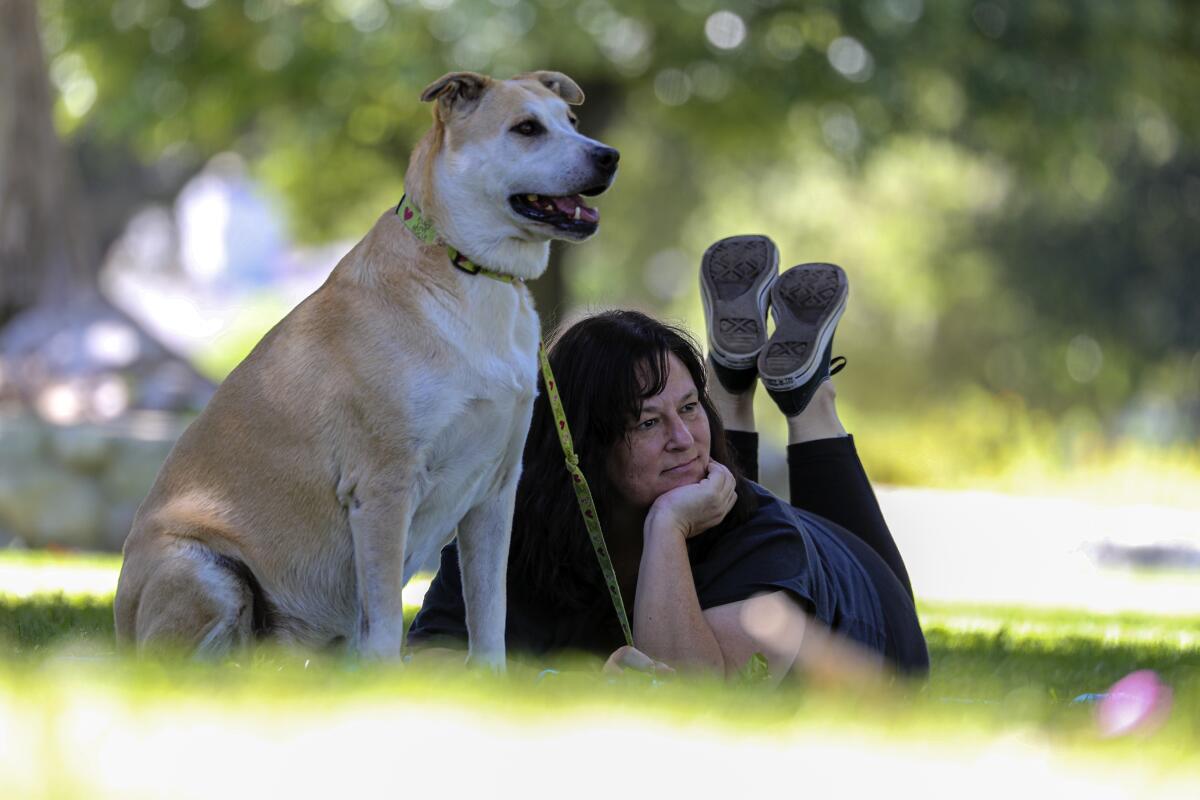
(Irfan Khan / Los Angeles Times)
Take in the sprawling American elms in Memorial Park and walk through the surrounding area of Claremont, home to more than 23,000 trees, including eucalyptus trees on College Avenue and camphor trees in the city’s popular Claremont Village.
The park is also home to the historic Garner House, and in the summer, the city of Claremont hosts Monday night Concerts in the Park in the bandshell.
Hours: Open from 6 a.m. to 10 p.m.
The park is also home to the historic Garner House, and in the summer, the city of Claremont hosts Monday night Concerts in the Park in the bandshell.
Hours: Open from 6 a.m. to 10 p.m.
Show more Show less
Route Details
Rancho Los Alamitos
Long Beach Park
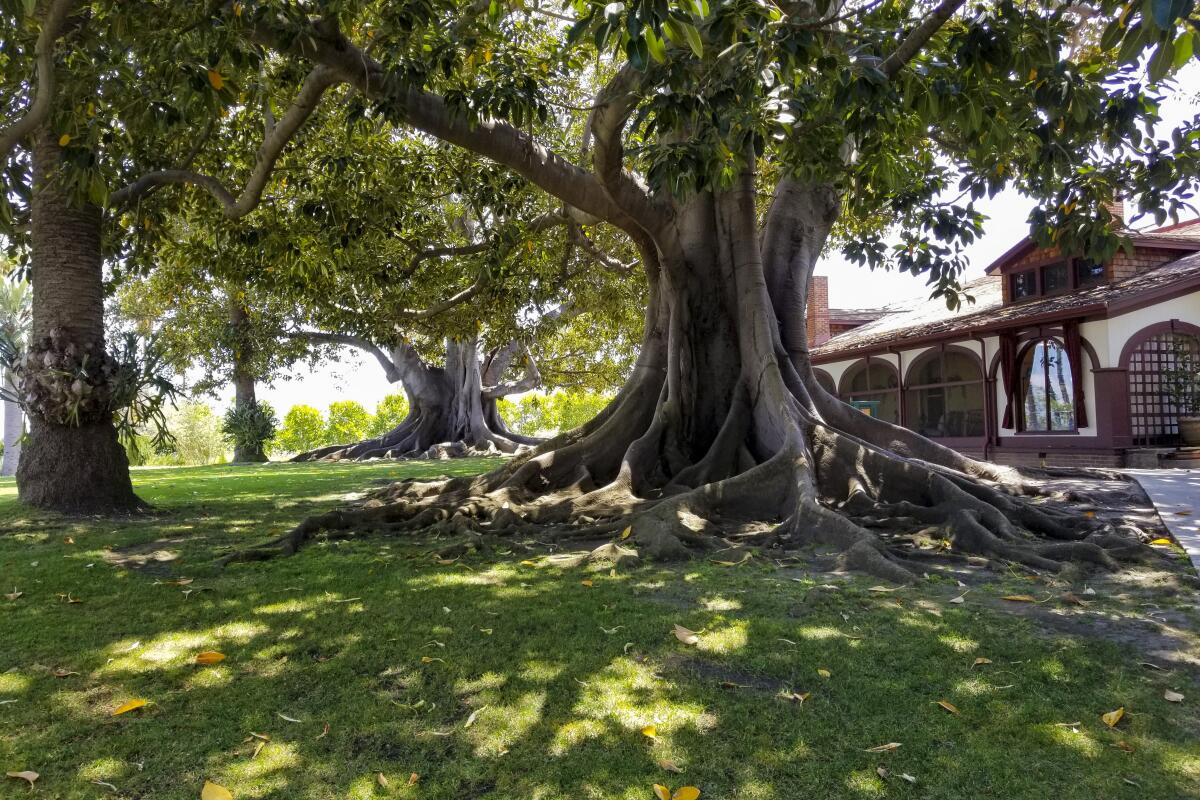
(Donna Skinner)
Tucked away in a gated residential community, this historic landmark includes 4 acres of gardens, a ranch house and a restored barnyard filled with horses, sheep, goats, chickens and ducks, surrounded by Canary Island palms and two enormous Moreton Bay fig trees, planted around 1888.
Hours: Open 1 to 5 p.m. Wednesdays through Sundays
Admission: Free
Hours: Open 1 to 5 p.m. Wednesdays through Sundays
Admission: Free
Show more Show less
Route Details
Santa Fe Dam Recreational Area
Irwindale Park

(Robert Gauthier / Los Angeles Times)
Ride your bike around the lake and through the park and you’ll find hundreds of new coast live oaks planted along the trail. While there are beautiful mature trees in this open space, it’s also exciting to imagine how cool and shady this park will be in five years.
The park includes a nature center, native plant garden, a waterless plant experimental garden, a Native American gathering circle, nature trails and picnic areas.
Hours: Open daily from 6 a.m. to 8 p.m. March 1 to Oct. 31; the Nature Center is open from 10 a.m. to noon on Saturdays.
Admission: Free. Vehicle entry fee $12.
The park includes a nature center, native plant garden, a waterless plant experimental garden, a Native American gathering circle, nature trails and picnic areas.
Hours: Open daily from 6 a.m. to 8 p.m. March 1 to Oct. 31; the Nature Center is open from 10 a.m. to noon on Saturdays.
Admission: Free. Vehicle entry fee $12.
Show more Show less
Route Details
South Coast Botanic Garden
Rolling Hills Estates Garden

(Chuck Bennett)
South Coast Botanic Garden recently celebrated its 60th birthday, marking its transformation from a county landfill covering an old diatomaceous earth mine to 87 acres of lush, diverse collections of extraordinary plants. The plantings include an almost spiritual banyan grove, with its tangle of huge Moreton Bay fig tree roots and massive canopy, along with gardens dedicated to a variety of botanic wonders such as roses, California native plants, dahlias, agaves, ginkgoes, eucalyptus and grass (yes, grass). The children’s garden has a nursery rhyme theme with a large dollhouse, a charming bridge and plants matched to the stories. You can visit the compost demonstration site to learn how to make your own at home.
All in all, the garden has more than 2,500 different species of plants and five miles of trails, but if that feels overwhelming, the garden’s website offers a downloadable map for easy planning, along with suggestions for what to see based on how much time you have to visit.
The garden also has two popular seasonal events that require an additional fee: SOAR, its butterfly pavilion and garden that is currently focused on monarch butterflies, and GLOW (Garden Lights & Ocean Waters), its winter light show. If you have only 45 minutes, you can see a lot at this garden, but if you’ve got the time, it’s an easy, fragrant place to while away an entire afternoon. Just remember to bring something to eat.
Hours: Open 8 a.m. to 5 p.m. daily except Dec. 25.
Admission: Reserved tickets required; $15, $11 seniors 62+ and students, $5 children ages 5-12, free for members and children 4 and younger. (Members need to reserve tickets only on weekends.) Free admission with reservations on the third Tuesday of each month. Annual membership is $45 for individuals and $65 for two adults and up to four children under 18.
Food isn’t available for purchase. Carry-in food is permitted. No pets permitted except trained service dogs. Dogs are permitted if leashed only on designated dog-walking days about 10 times a year.
All in all, the garden has more than 2,500 different species of plants and five miles of trails, but if that feels overwhelming, the garden’s website offers a downloadable map for easy planning, along with suggestions for what to see based on how much time you have to visit.
The garden also has two popular seasonal events that require an additional fee: SOAR, its butterfly pavilion and garden that is currently focused on monarch butterflies, and GLOW (Garden Lights & Ocean Waters), its winter light show. If you have only 45 minutes, you can see a lot at this garden, but if you’ve got the time, it’s an easy, fragrant place to while away an entire afternoon. Just remember to bring something to eat.
Hours: Open 8 a.m. to 5 p.m. daily except Dec. 25.
Admission: Reserved tickets required; $15, $11 seniors 62+ and students, $5 children ages 5-12, free for members and children 4 and younger. (Members need to reserve tickets only on weekends.) Free admission with reservations on the third Tuesday of each month. Annual membership is $45 for individuals and $65 for two adults and up to four children under 18.
Food isn’t available for purchase. Carry-in food is permitted. No pets permitted except trained service dogs. Dogs are permitted if leashed only on designated dog-walking days about 10 times a year.
Show more Show less
Route Details
Storrier Stearns Japanese Gardens
Pasadena Garden

(Jose J. Salcedo)
This tiny jewel of a garden was once part of a palatial Pasadena estate designed by Japanese landscaper Kinzuchi Fujii for his wealthy patrons, Charles and Ellamae Storrier Stearns. Fujii transformed two flat tennis courts into a 3/4 acre mounded garden featuring a grand “12-tatami-mat tea house” (a dozen 3-foot-by-6-foot mats, signifying a house of great importance) along with two waterfalls, two ponds, four bridges and numerous plantings shaded by sprawling sycamores and oaks. It’s a restful place to wander by day, but it’s even more magical at night, with just enough lighting to help you find your way along the paths.
This privately-owned nonprofit garden has limited hours. But if you’re looking for a special evening out on Friday or Saturday, grab your favorite takeout and even a bottle of wine and watch the day melt into night, with strings of lights reflecting off the pond. The teahouse is lighted but no longer open to visitors except during special events. “People were coming and doing yoga in there,” said site manager Heidi Ferraro, “so now it’s only open for tea ceremonies.”
Admission: Tickets are $15 on Fridays and Saturdays and $12 on Sundays for people 13 and older. People 12 and younger enter free.
Hours: Open 4 to 8 p.m. Fridays and Saturdays, unless the garden is rented for a special event, and 10 a.m. to 4 p.m. Sundays. Note that hours vary based on the season and site rentals, so be sure to check the website before you go. Shorter hours happen in the winter after daylight saving time.
Food: No food is sold at the garden, but you can bring your own food and drink. Be sure to bring your own cups, bottle openers, cutlery and plates and take it all out with you when you leave.
Other: Most of the garden is wheelchair-accessible. Pets are not permitted.
This privately-owned nonprofit garden has limited hours. But if you’re looking for a special evening out on Friday or Saturday, grab your favorite takeout and even a bottle of wine and watch the day melt into night, with strings of lights reflecting off the pond. The teahouse is lighted but no longer open to visitors except during special events. “People were coming and doing yoga in there,” said site manager Heidi Ferraro, “so now it’s only open for tea ceremonies.”
Admission: Tickets are $15 on Fridays and Saturdays and $12 on Sundays for people 13 and older. People 12 and younger enter free.
Hours: Open 4 to 8 p.m. Fridays and Saturdays, unless the garden is rented for a special event, and 10 a.m. to 4 p.m. Sundays. Note that hours vary based on the season and site rentals, so be sure to check the website before you go. Shorter hours happen in the winter after daylight saving time.
Food: No food is sold at the garden, but you can bring your own food and drink. Be sure to bring your own cups, bottle openers, cutlery and plates and take it all out with you when you leave.
Other: Most of the garden is wheelchair-accessible. Pets are not permitted.
Show more Show less
Route Details
UC Riverside Botanic Gardens
Riverside Garden

(Jodie Holt)
If you’re looking for a garden experience and a workout, UC Riverside’s Botanic Gardens is a wonderful option. The gardens appear small at the entrance, but the trees get denser and taller as you walk to the interior and follow the paths up the hill. Here the 40-acre garden unfolds with four miles of trails through gardens devoted to butterfly habitat, herbs, irises and lilacs (that will bloom during Riverside’s mild winters) and more than 300 species of roses. An online map shows a network of trails, some paved and suitable for wheelchairs and others that are rutted, steep and challenging to negotiate. You’ll find an orchard devoted to subtropical fruit, from citrus and avocados to guavas and sapotes, and a new garden dedicated to plants important to the Indigenous people of inland Southern California.
The garden also has collections from a variety of geographical areas, including Australia and South Africa, as well as the eastern United States, with its temperate deciduous forests and North American deserts. And, of course, it also covers regions of California, from Baja and the California chaparral to North Coast redwood forests, oak woodlands, coastal sage scrub — native to the hills where the gardens are located — and a lovely shady area known as Alder Canyon full of native California riparian trees.
Admission: No charge but suggested $5 donation.
Hours: Open Sunday-Friday during the summer from 8 a.m. to 2 p.m. Master Gardener docents are available in the butterfly garden the first and third Sunday of every month through October from 9 a.m. to noon to answer questions about gardening for butterflies. The campus calendar is here.
Food not available for purchase. Pets are not permitted in the garden.
The garden also has collections from a variety of geographical areas, including Australia and South Africa, as well as the eastern United States, with its temperate deciduous forests and North American deserts. And, of course, it also covers regions of California, from Baja and the California chaparral to North Coast redwood forests, oak woodlands, coastal sage scrub — native to the hills where the gardens are located — and a lovely shady area known as Alder Canyon full of native California riparian trees.
Admission: No charge but suggested $5 donation.
Hours: Open Sunday-Friday during the summer from 8 a.m. to 2 p.m. Master Gardener docents are available in the butterfly garden the first and third Sunday of every month through October from 9 a.m. to noon to answer questions about gardening for butterflies. The campus calendar is here.
Food not available for purchase. Pets are not permitted in the garden.
Show more Show less
Route Details
Bette Davis Picnic Area
Glendale Park
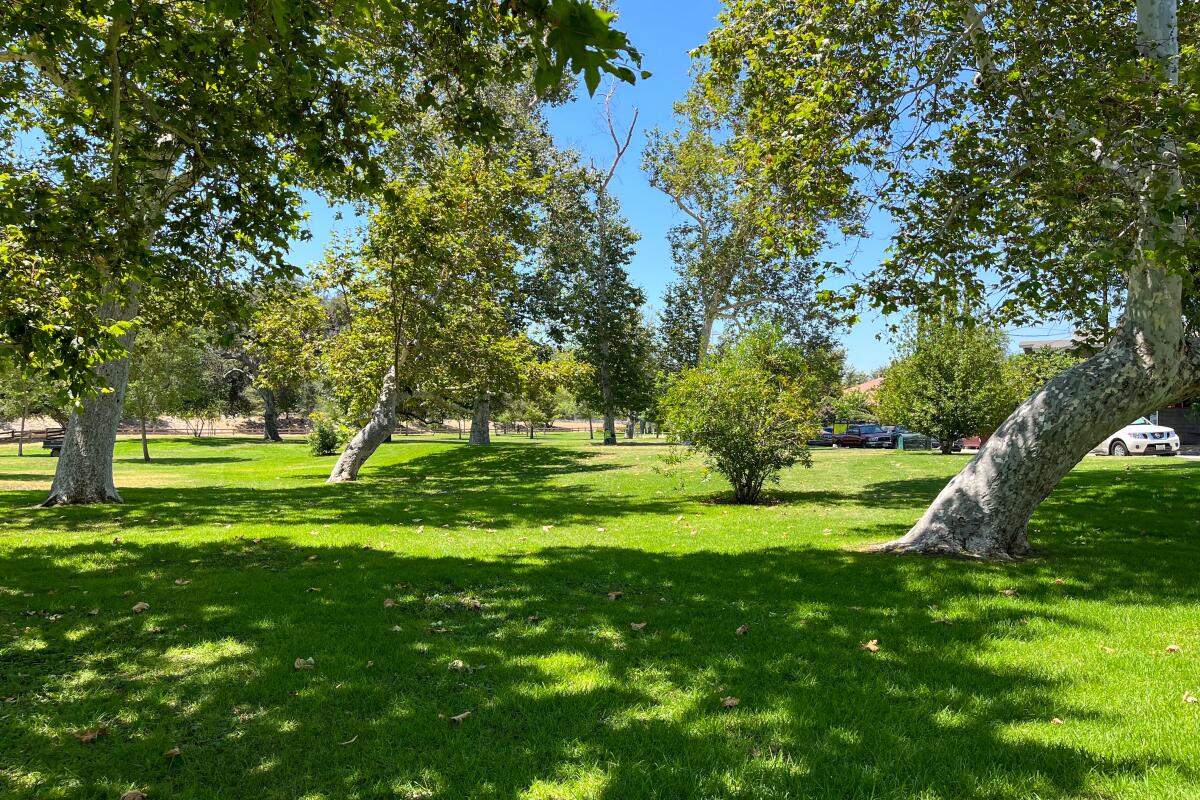
(Anna Braz / Los Angeles Times)
The Bette Davis picnic area, located just north of Griffith Park, is a hidden gem. It was named after movie star Bette Davis, who used to live nearby on Rancho Drive. The area is covered in soft green grass, perfect for laying down a blanket for a summer picnic. Sycamore, jacaranda and California bay trees provide some much-needed shade on a hot August or fall day. Dozens of monarch and likely Western Tiger Swallowtail butterflies flew between the trees on a recent visit. (An on-site park employee identified the butterflies and trees for this reporter.) A native micro-forest grows in the area as well. The micro-forest was created in 2021 by the L.A. Parks Foundation using the Miyawaki Method, which involves planting only indigenous species in hopes of creating a sustainable, low-maintenance forest for years to come. Whether you’re looking for a shady spot to relax and enjoy nature or interested in seeing a micro-forest in action, this spot is the place to be. There is free street parking next to the park on Riverside Drive.
Show more Show less
Route Details
Vista Hermosa Natural Park
Echo Park Park
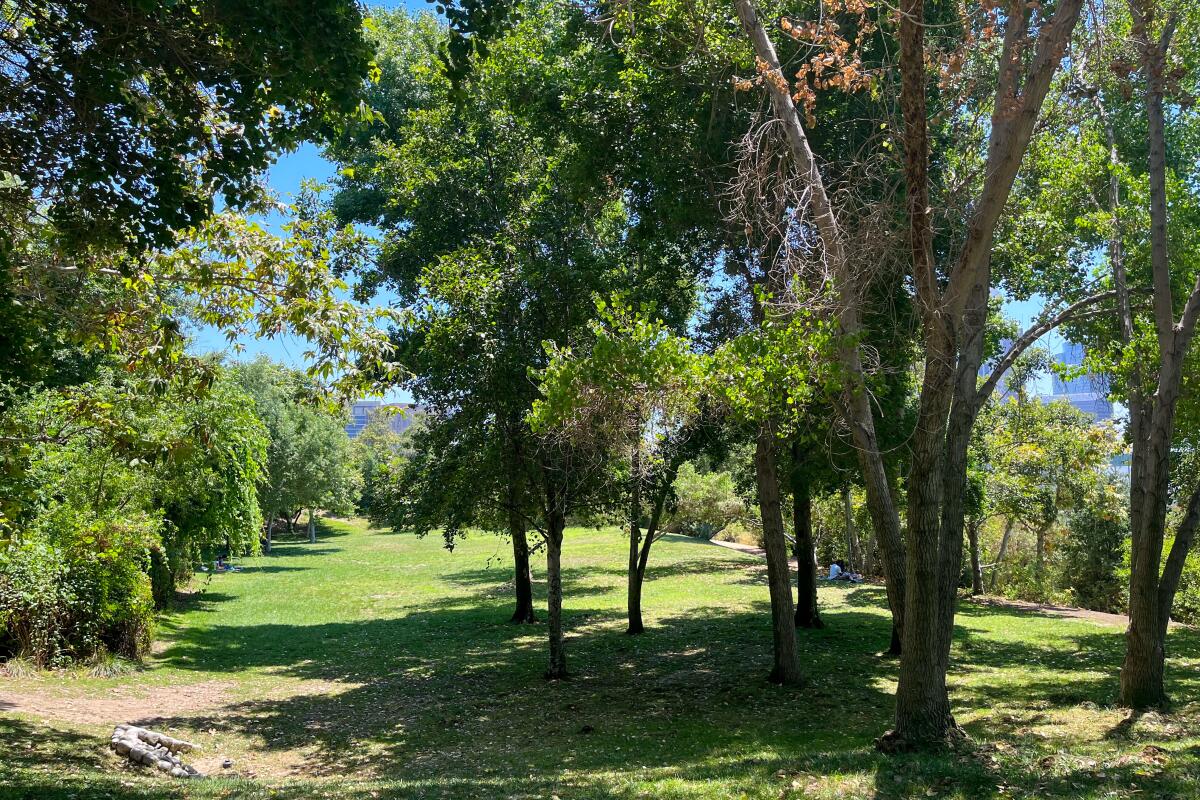
(Anna Braz / Los Angeles Times)
The Vista Hermosa Natural Park is a serene sanctuary on a hot day. Located in Echo Park near the western gateway to downtown Los Angeles, the park offers visitors plenty of shady spots to beat the heat during the summer and fall. Tree-covered walking trails, picnic grounds, meadows and a nature-themed playground are just some of the amenities. On a recent afternoon visit, people could be seen enjoying the shaded grass, including a family having a picnic and a couple throwing a tennis ball with their dog. There is free street parking, a small parking lot near the North Toluca Street entrance and free restrooms. The park is closed 30 minutes after sunset to 30 minutes before sunrise each day.
Show more Show less
Route Details
Will Rogers Memorial Park
Beverly Hills Park
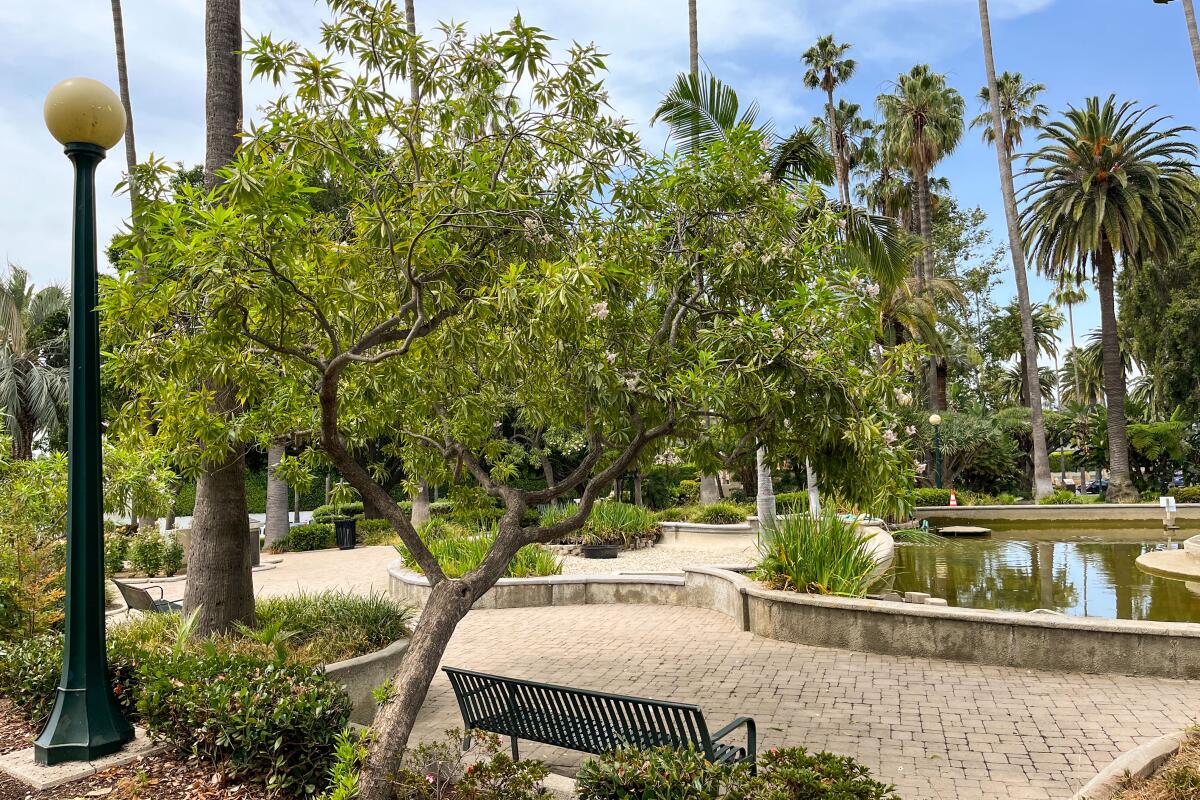
(Anna Braz / Los Angeles Times)
You can find Will Rogers Memorial Park in Beverly Hills on Sunset Boulevard near the iconic Beverly Hills Hotel. This tranquil spot offers tons of shady lounging areas including benches, lawns and a central fountain protected from the sun by many large trees. A California ground squirrel was spotted enjoying the fountain water on a recent visit. Often you’ll find ducks and turtles in the fountain. The park was formerly called Sunset Park but was later renamed in 1952 after the 20th century movie star Will Rogers, who was appointed the “honorary mayor” of Beverly Hills in 1926. There is free two-hour street parking on the streets that surround the park — Sunset Boulevard, North Beverly Drive and North Canon Drive. The park is open from 6 a.m. to 10 p.m. every day.
Show more Show less
Route Details
Garfield Park
South Pasadena Park
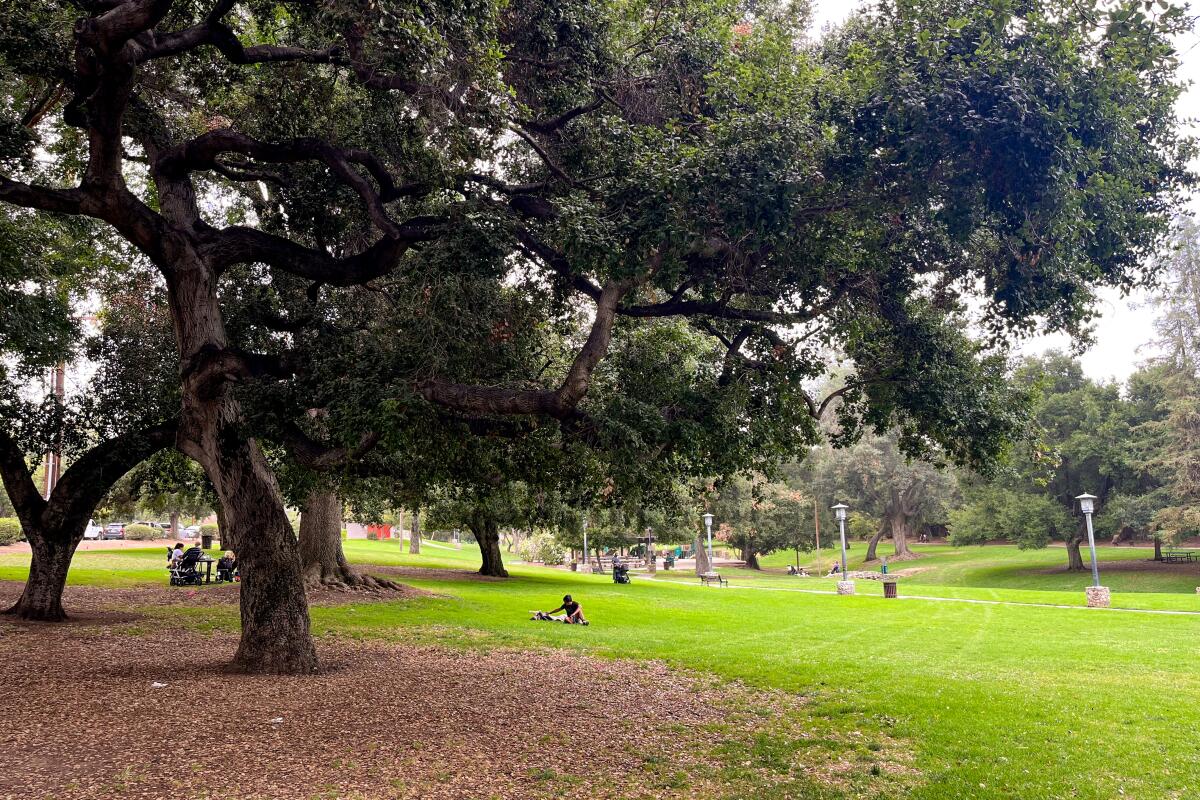
(Anna Braz / Los Angeles Times)
Stay cool this summer and fall in Garfield Park, located on Mission Street in South Pasadena. Tall sycamore, fig and a variety of other trees offer shade along with two covered gazebos with picnic tables underneath. Visitors are greeted with the scent of a rose garden at the entrance and they can relax on the vibrant green grass covering the ground of this expansive seven-acre park. If this reporter were a kid again, the playground at the center of the park would look very appealing. There is free parking on the streets surrounding the park, which is open from 5 a.m. to 10 p.m. every day.
Show more Show less
Route Details
Virginia Robinson Gardens
Beverly Hills Private garden
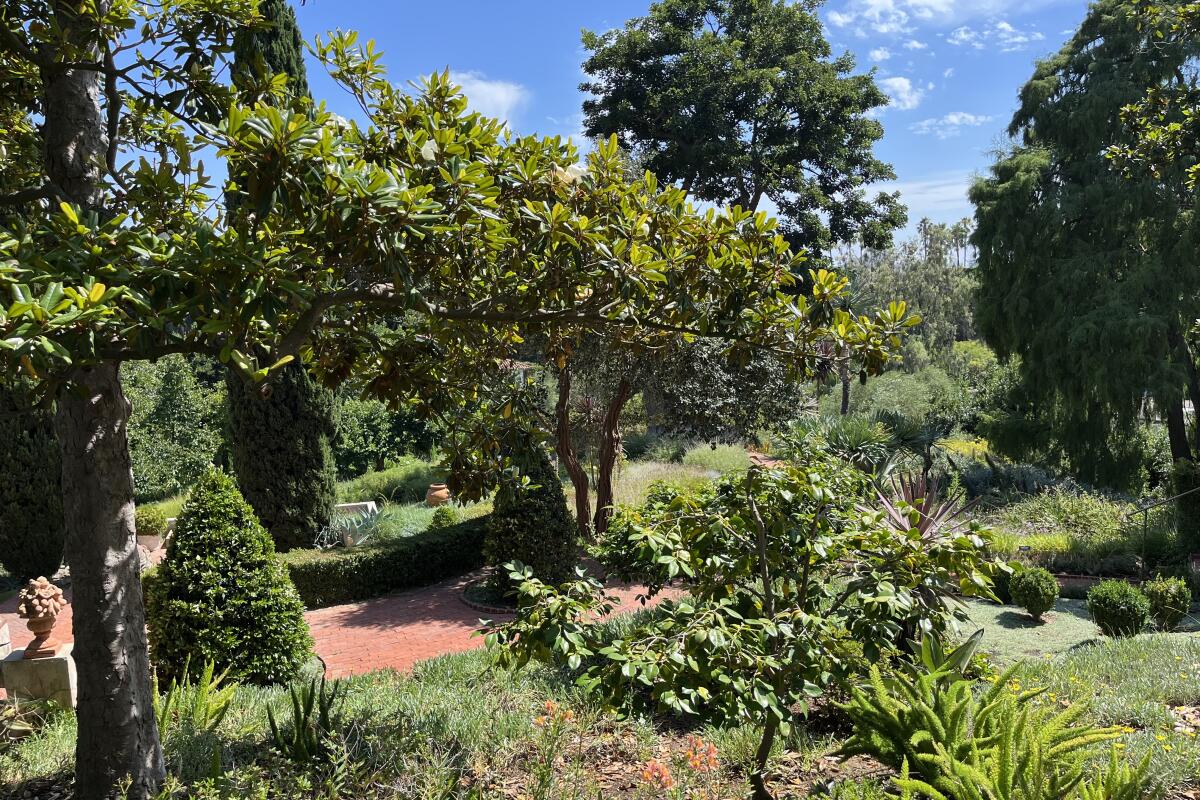
(Anna Braz / Los Angeles Times)
The Virginia Robinson Gardens in Beverly Hills is a green oasis oozing with history. Built in 1911, this luxury estate belonged to Virginia and Harry Robinson of Robinson‘s department stores. The property’s rose garden, Italian terrace, pool pavilion and great lawn transport visitors back to a Gatsby-era scene, as Virginia once hosted many star-studded parties there. Unique species of plants grow throughout the property’s gardens, including what is said to be the largest coral tree in California and a massive group of king palms — both of which provide lots of shade. Docent-led tours are available to the public at 10 a.m. and 1 p.m. Monday through Friday and must be booked online in advance. Admission is $15 for adults, $6 for children and $11 for students with ID and seniors. The gardens also offer yoga, art and other classes that can be found on its website’s event schedule. There is a visitor parking lot on-site that can be accessed through the gate at the end of 1008 Elden Way.
Show more Show less
Route Details
No matching entries.
Please reset filters to see all entries.
No matching entries.
Please reset filters to see all entries.
Top








